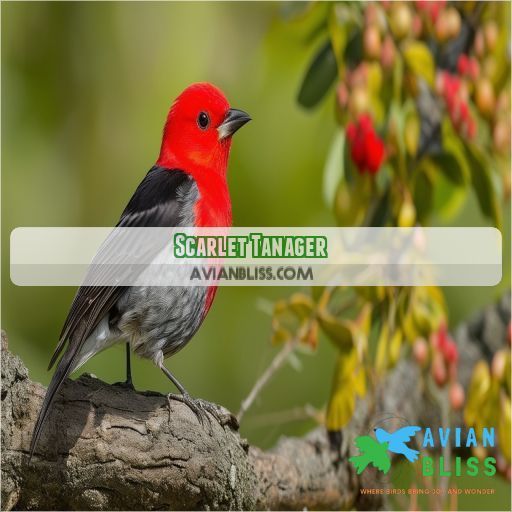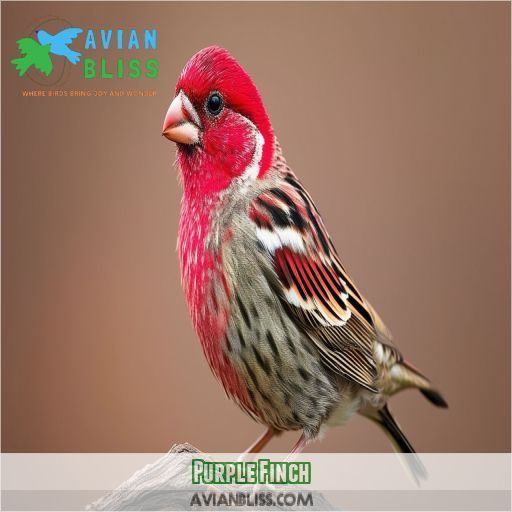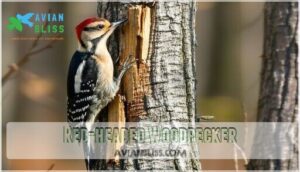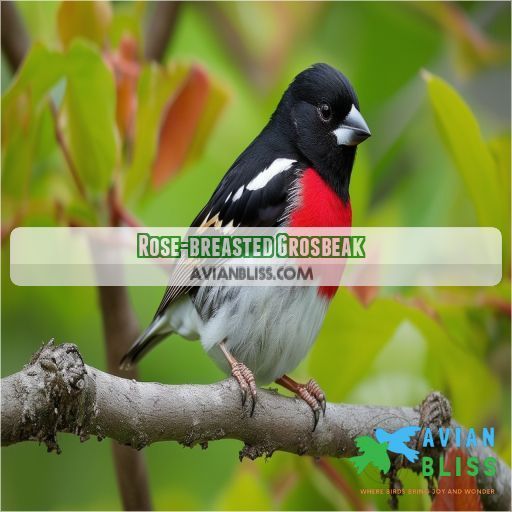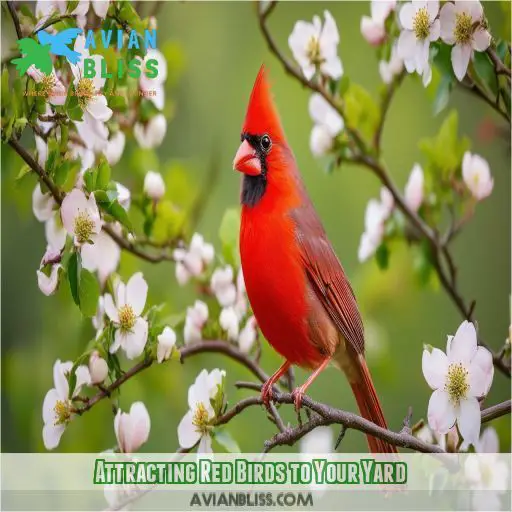This site is supported by our readers. We may earn a commission, at no cost to you, if you purchase through links.
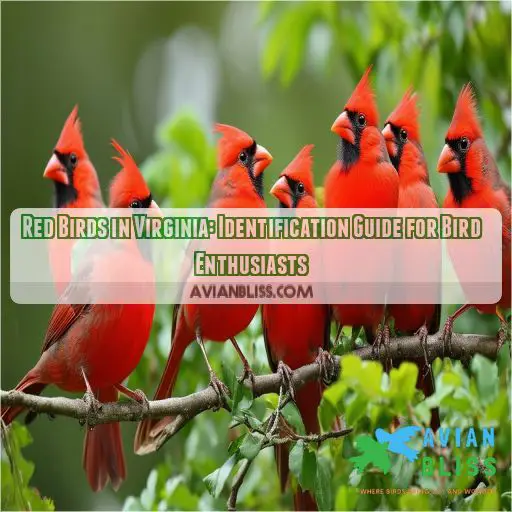
You’ll spot the iconic Northern Cardinal, a year-round resident with its bright red plumage, in forests and backyards alike. The House Finch, with its reddish-purple head, is another common sight.
During summer, keep an eye out for the vibrant Scarlet Tanager high in the treetops. The American Robin, though not entirely red, boasts a rusty red breast. Don’t forget the Summer Tanager, found in open woodlands.
These red birds in Virginia offer a feast for the eyes and a challenge for bird enthusiasts. Stick around to uncover more avian treasures in the Old Dominion.
Table Of Contents
Key Takeaways
- Virginia’s got more red feathers than a cardinal convention! From the year-round Northern Cardinal to the summer-loving Scarlet Tanager, there’s a crimson-crested critter for every season.
- These ruby-hued avians aren’t just eye candy – they’re nature’s own pest control and berry dispersal squad. Talk about multitasking!
- Want to turn your backyard into a red bird resort? Break out the sunflower seeds and berry bushes. Just don’t be surprised if your yard starts looking like a feathered fashion show.
- Keep your eyes peeled and your binoculars ready – some of these scarlet stunners, like the Purple Finch, are sneaky winter visitors. They’re like nature’s own hide-and-seek champions!
Northern Cardinal
You can identify the Northern Cardinal by its bright red male and brown female, making it a striking sight in Virginia’s habitats. This year-round resident thrives in forests, parks, and backyards while feeding on seeds, berries, and insects.
Bright Red Male, Brown Female
The Northern Cardinal stands out, with the male’s striking red plumage contrasting the female’s more subdued brown feathers . They nest in dense shrubs, showing strong parental care during the breeding season. Unlike migratory species like the Scarlet and Summer Tanagers, Northern Cardinals stay put, providing vibrant color year-round (Source). Watch for Rose-breasted Grosbeak visits in migration periods .
Year-round Resident
As a bird enthusiast in Virginia, you’re in luck! The Northern Cardinal is a year-round resident, providing a splash of bright red color to your backyard or local park. Here are three key facts to keep in mind:
- Habitat preference: Cardinals thrive in gardens and forests with dense shrubs and trees.
- Seed preference: They love sunflower seeds, so consider adding them to your bird feeders.
- Conservation: While not currently threatened, habitat loss and fragmentation can impact local populations.
Found in Forests, Parks, and Backyards
You’ll often spot Northern Cardinals in various forest habitats and birding locations such as parks and backyards. These vibrant, red-feathered backyard visitors frequent bird feeders as well. Sharing their spaces with the House Finch and Red-bellied Woodpecker, cardinals bring bursts of color to areas where the elusive Painted Bunting and Common Redpoll may also appear.
Eats Seeds, Berries, and Insects
When you spot a Northern Cardinal in your backyard, you’ll find that their diet is diverse and adaptive. They eat seeds, berries, and insects, guaranteeing they thrive year-round. Key foods include:
- Seeds: Sunflower, millet, and cracked corn.
- Berries: Blackberries, raspberries, and dogwood.
- Insects: Beetles, grasshoppers, and caterpillars.
Their varied diet guarantees they remain vibrant and healthy.
House Finch
Discuss the House Finch, a year-round resident in Virginia known for its reddish-purple head and breast, brown back, commonly found in parks, farms, and backyards, with a diet comprising black oil sunflower seeds and nyjer seeds.
Reddish-purple Head and Breast, Brown Back
Next, let’s discuss the House Finch. Recognized by its reddish-purple head and breast and a brown back, the House Finch is another colorful presence in Virginia. These birds thrive in parks, farms, and backyards, often visiting feeders. Their diet typically includes black oil sunflower seeds and nyjer seeds.
| House Finch | |
|---|---|
| Habitat | Parks, farms, backyards |
| Diet | Black oil sunflower seeds, nyjer seeds |
| Behavior | Social, gregarious; known for their jumbled, warbled song in the mornings (Source) |
Year-round Resident (introduced Species)
House Finches are interesting as year-round residents that were introduced species from western North America. They thrive in various settings thanks to their adaptability.
- Origin: Native to the West
- Range: Now widespread across the US and Canada
- Migration: Generally sedentary, with minor seasonal movements
- Abundance: Highly abundant
- Habits: Readily found near human habitations
Common in Parks, Farms, and Backyards
House Finches are common in parks, farms, and backyards, making them easy to spot throughout Virginia. Their habitat spans various environments, supporting their adaptability. Look for their distinguishing features: reddish-purple head and breast with a brown back. These sociable birds often gather in noisy groups, enriching your birdwatching experience with their lively presence and melodious songs.
Eats Black Oil Sunflower Seeds and Nyjer Seeds
You’re likely familiar with the House Finch, a common bird in Virginia’s backyards and parks. This bird’s dietary preferences are quite specific. Here are its favorite snacks:
- Black oil sunflower seeds
- Nyjer seeds
- Suet
American Robin
When observing the American Robin, you’ll notice its distinctive rusty red breast contrasted with a dark head and back. This bird’s diet consists largely of insects, worms, and berries, making it a common sight in various habitats across Virginia.
Rusty Red Breast, Dark Head and Back
When you spot a bird with a rusty red breast, dark head, and back, you’re likely seeing an American Robin. Their rufous coloration is striking, especially against their habitat overlap in deciduous forests and suburban areas. These robins exhibit interesting migratory patterns and have specific foraging preferences. Conservation concerns arise due to habitat changes and climate impact.
Eats Insects, Worms, and Berries
American Robins have diverse diets, enjoying insects, worms, and berries. You’ll see them hopping in your yard, pulling worms from the soil, or snacking on berries. Their food preferences make them easy to attract.
Here’s what they love:
- Earthworms, especially after a rainy day
- Various insects like beetles and caterpillars
- Juicy berries from holly or juniper (Source).
Scarlet Tanager
The Scarlet Tanager is a striking bird, with bright red males and yellow females that stand out in Virginia’s summer forests . You’ll often spot them high among the treetops, feasting on berries and insects .
Bright Red Male, Yellow Female
You’re likely to spot a Scarlet Tanager in Virginia’s forests during the summer months. The bright red male and yellow female are a stunning sight. Take a closer look at their characteristics:
| Male | Female | |
|---|---|---|
| Plumage | Bright scarlet red | Yellow |
| Wings | Black | Black |
| Habitat | Forests | Forests |
| Diet | Berries, insects | Berries, insects |
| Behavior | Migratory | Migratory |
These birds are known for their migratory behavior, flying high in the treetops, and feasting on berries and insects.
Summer Resident
As a summer resident, the Scarlet Tanager captivates with its stunning appearance. During the breeding season, they migrate north and prefer nesting in large, undisturbed forests:
- Mating involves distinctive courtship rituals.
- Their calls consist of short, blended whistling notes.
- They forage in treetops for insects and berries.
scarlet tanagers demonstrate fascinating behaviors during their northward summer migration.
Found High Among Treetops in Forests
Scarlet Tanagers, with their stunning scarlet plumage, prefer the high treetops of dense, mature forests during the summer. These elusive birds are often hard to spot because they stay high up in the forest canopy. Their habitat preference for large, continuous forest blocks is essential for their nesting sites and successful breeding .
Eats Berries and Insects
When spotting Scarlet Tanagers during your summer bird-watching adventures, you’ll notice their vibrant red males high in treetops. Their diet consists of berries and insects, making berry bushes and insect feeders perfect for attracting these stunning visitors.
- Plant berry bushes.
- Set up insect feeders.
- Watch for high-flying red males.
- Enjoy their summer visits. .
Summer Tanager
You can spot the Summer Tanager in Virginia’s open woodlands, where it stands out with its bright red color. This bird’s diet consists primarily of bees, wasps, and berries, which it actively searches for during the day.
Found in Open Woodlands
The Summer Tanager thrives in open woodlands, often hiding within the forest canopy. You’ll spot them in habitats rich with diverse tree species. These vibrant birds prefer areas that provide ample cover and food sources throughout their life stages, staying within wooded regions during breeding and migration periods.
| Seasonal Behavior | Habitat | Migration Pattern |
|---|---|---|
| Breeding Season | Open Woodlands | Migrates South |
| Migration Period | Diverse Forest Canopy | Moves from North to South |
| Winter Months | Wooded Areas in Tropics | Central and South America |
Eats Bees, Wasps, and Berries
The Summer Tanager, a bright red bird, features fascinating dietary adaptation and migratory behavior. It confidently snatches bees and wasps mid-air, showcasing remarkable agility. It also enjoys berries, contributing to its versatile diet. Understanding its habitat use and conservation concerns can help preserve this migratory species.
- Feasts on bees
- Catches wasps
- Eats berries
- Migrates south
Purple Finch
To spot a Purple Finch in Virginia, look for males displaying reddish-purple hues on their head and breast with a brown back. These winter visitors thrive in evergreen forests, feeding on conifer seeds, buds, nectar, and berries.
Males Are Reddish-purple on Head and Breast, Brown Back
Moving from the beautiful Summer Tanager, let’s focus on the Purple Finch. Males exhibit a striking reddish-purple on their head and breast, contrasting with their brown back. Notably, this introduced species is a year-round resident. To attract them to your yard, provide black oil sunflower seeds and nyjer seeds, as they relish these treats.
Winter Visitor
As winter visitors, Purple Finches exhibit interesting migration patterns, often influenced by food availability. Their robust beak morphology aids in cracking conifer seeds during winter feeding. Their cold adaptations allow them to thrive in colder climates, making them an incredible example of resilience and versatility. Purple Finches prefer varied habitats offering ample food sources during harsh winters.
Found in Evergreen Forests
You’ll find Purple Finches nestled in cool evergreen forests during their breeding season. Their strong adaptation to these habitats, including dependency on conifer seeds and winter migration patterns, makes habitat conservation essential. During winter, Purple Finches migrate south, seeking suitable climates.
- Thrive in lush emerald-canopied forests
- Rely on ample conifer resources
- Seasonal migrations guarantee survival
Eats Conifer Seeds, Buds, Nectar, and Berries
Purple Finches, winter visitors, thrive in evergreen forests. With a diet heavily reliant on conifer seeds, their nutritional needs are well met. Besides, they relish buds, nectar, and berries. Their versatility extends to consuming insects, which provides a balanced diet. This varied diet makes certain they stay healthy and energetically navigate the cold months.
Red-bellied Woodpecker
In Virginia, you’ll often spot Red-bellied Woodpeckers, distinguished by their subtle red belly and barred back, inhabiting open woods and visiting bird feeders . They enjoy a diet consisting of insects, nuts, and seeds, making them a frequent presence in varied environments .
Hint of Red on Belly, Not Fully Red
You’ve likely spotted the Red-bellied Woodpecker in Virginia’s open woods. Despite its name, it only has a hint of red on its belly, not fully red. This bird features vibrant red on its head and nape, with a striking black-and-white barred back. Its diet variations include insects, nuts, and seeds, reflecting its diverse habitat preferences.
Found in Open Woods and Visits Bird Feeders
You’ll find the Red-bellied Woodpecker in open woodlands and visiting bird feeders frequently. Unlike the Summer Tanager, which exhibits migratory behavior, the Red-bellied Woodpecker is non-migratory and stays year-round. Its preference for open woodlands makes it a familiar sight during any season, easily attracted to your yard with a suitable feeder offering.
Eats Insects, Nuts, and Seeds
The Red-bellied Woodpecker, found in open woods and visiting bird feeders, boasts a diverse diet. You’ll observe them consuming insects, nuts, and seeds, which supports their active foraging behavior. These birds often store food, displaying fascinating survival tactics critical to their conservation. A familiar sight year-round, they add vibrancy and charm to Virginia’s bird habitats and ecosystems.
Red-headed Woodpecker
You’ll easily spot the Red-headed Woodpecker with its striking bright red head and black and white body. Look for these distinctive birds in parks and woods with old trees, where they search for insects and nest in cavities.
Bright Red Head, Black and White Body
You’ll be amazed by the striking appearance of the Red-headed Woodpecker. Unlike its Red-bellied cousin, this bird sports a fully bright red head that contrasts sharply with its black and white body, similar to the vibrant plumage of the American Northern Cardinal species
.
It’s a year-round resident in Virginia, adding a splash of color to your birding adventures.
Keep your eyes peeled for this stunning creature as you explore parks and woods with old trees.
Found in Parks and Woods With Old Trees
You’ll spot red-headed woodpeckers in parks and forests with old trees, their preferred habitats. These striking birds need mature woodlands for nesting and foraging.
Unlike their cousins, they’re not shy about venturing into open areas. Keep an eye out for their distinctive red, black, and white plumage as they flit between trees, searching for insects or nuts.
Their presence often indicates a healthy ecosystem.
Rose-breasted Grosbeak
You’ll easily spot a Rose-breasted Grosbeak by its distinctive black head, white chest, and vibrant red bib. These striking birds prefer deciduous forests and parks, where you can often find them perched high in the treetops or foraging for insects and berries.
Black Head, White Chest, Red Bib
You’ll find the Rose-breasted Grosbeak’s appearance striking and easy to identify.
The male sports a bold black head, contrasting with a crisp white chest. What really catches your eye is the vibrant red bib splashed across its breast. This color pattern makes it stand out among other birds.
Females, however, have a more subtle brown streaked pattern, lacking the dramatic black-white-red combo of their male counterparts.
Found in Deciduous Forests and Parks
You’ll find the Rose-breasted Grosbeak in deciduous forests and parks, sharing habitats with other red-hued birds. Its striking coloration makes it a favorite among birdwatchers. As a migratory species, it’s not a year-round resident in Virginia. To spot one, keep an eye out for:
- Tall trees where they often perch
- Fruiting shrubs they feed on
- Bird feeders with sunflower seeds
- Open areas near forest edges where they forage
Their behavior includes melodious singing and acrobatic feeding.
Attracting Red Birds to Your Yard
To attract red birds to your yard, you’ll need to cater to their dietary preferences and habitat needs.
For Northern Cardinals, set out sunflower seeds, peanut hearts, and millet. House Finches love black oil sunflower seeds and nyjer seeds. If you’re hoping to lure in Scarlet or Summer Tanagers, plant berry bushes and fruit trees. Purple Finches, winter visitors with a conservation status to watch, will flock to black oil sunflower seeds too.
Consider migration patterns when planning your bird-friendly space. Create a diverse habitat with trees, shrubs, and open areas to accommodate various species’ physical characteristics and behaviors.
Don’t forget water sources! A birdbath or small fountain can be a game-changer.
Frequently Asked Questions (FAQs)
How do red birds colors change with the seasons?
Like a chameleon’s coat, some red birds transform with the seasons. You’ll notice male scarlet tanagers shed their vibrant red for olive-green in winter. Summer tanagers also lose their brilliant hue, while cardinals maintain their fiery plumage year-round.
Are there any red birds unique to Virginia?
While Virginia doesn’t have red birds unique to the state, you’ll find several striking species. Northern Cardinals are year-round residents, while Scarlet and Summer Tanagers visit in summer. Each brings its own vibrant charm to Virginia’s landscapes.
What predators commonly target red birds in Virginia?
You’ll find red birds facing threats from various predators. Hawks, owls, and falcons swoop down from above, while snakes and raccoons raid nests. Domestic cats pose a significant danger, especially in urban and suburban areas.
How do red birds communicate with each other?
Imagine a cardinal’s melodious whistle echoing through a Virginia forest. You’ll notice red birds communicate through songs, calls, and visual displays. They use these methods to attract mates, defend territories, and warn of dangers in their environment.
Can red birds interbreed with other bird species?
Most bird species can’t interbreed, but it’s not impossible. You’ll occasionally see hybrids between closely related species. For red birds, cardinal-pyrrhuloxia and tanager-grosbeak hybrids have been documented. However, these occurrences are rare in nature.
Conclusion
From the vibrant Northern Cardinal to the elusive Summer Tanager, Virginia’s red birds offer a mesmerizing array of avian beauty. You’ve now got the tools to identify these stunning creatures in your backyard or on your next nature hike.
Happy birdwatching!




